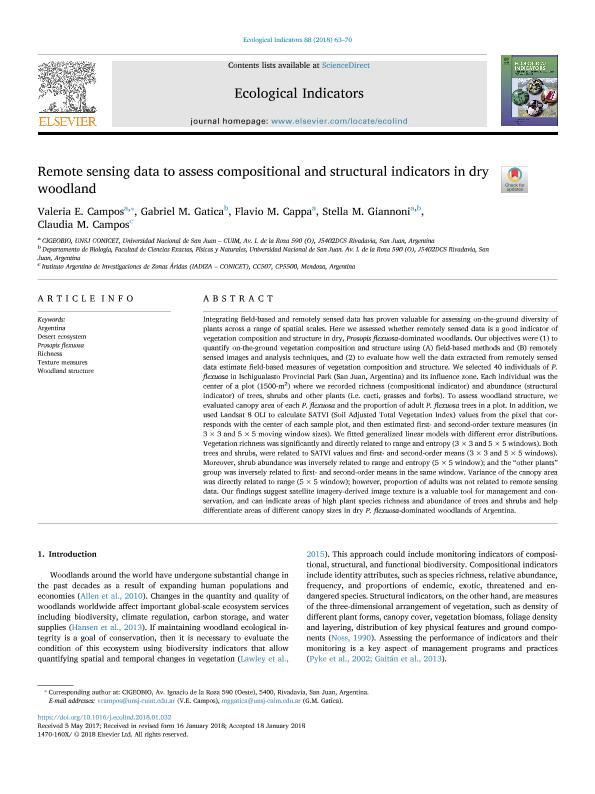Mostrar el registro sencillo del ítem
dc.contributor.author
Campos, Valeria Evelin

dc.contributor.author
Gatica, Mario Gabriel

dc.contributor.author
Cappa, Flavio Martín

dc.contributor.author
Giannoni, Stella Maris

dc.contributor.author
Campos, Claudia Monica

dc.date.available
2019-10-21T19:59:57Z
dc.date.issued
2018-05
dc.identifier.citation
Campos, Valeria Evelin; Gatica, Mario Gabriel; Cappa, Flavio Martín; Giannoni, Stella Maris; Campos, Claudia Monica; Remote sensing data to assess compositional and structural indicators in dry woodland; Elsevier Science; Ecological Indicators; 88; 5-2018; 63-70
dc.identifier.issn
1470-160X
dc.identifier.uri
http://hdl.handle.net/11336/86728
dc.description.abstract
Integrating field-based and remotely sensed data has proven valuable for assessing on-the-ground diversity of plants across a range of spatial scales. Here we assessed whether remotely sensed data is a good indicator of vegetation composition and structure in dry, Prosopis flexuosa-dominated woodlands. Our objectives were (1) to quantify on-the-ground vegetation composition and structure using (A) field-based methods and (B) remotely sensed images and analysis techniques, and (2) to evaluate how well the data extracted from remotely sensed data estimate field-based measures of vegetation composition and structure. We selected 40 individuals of P. flexuosa in Ischigualasto Provincial Park (San Juan, Argentina) and its influence zone. Each individual was the center of a plot (1500-m2) where we recorded richness (compositional indicator) and abundance (structural indicator) of trees, shrubs and other plants (i.e. cacti, grasses and forbs). To assess woodland structure, we evaluated canopy area of each P. flexuosa and the proportion of adult P. flexuosa trees in a plot. In addition, we used Landsat 8 OLI to calculate SATVI (Soil Adjusted Total Vegetation Index) values from the pixel that corresponds with the center of each sample plot, and then estimated first- and second-order texture measures (in 3 × 3 and 5 × 5 moving window sizes). We fitted generalized linear models with different error distributions. Vegetation richness was significantly and directly related to range and entropy (3 × 3 and 5 × 5 windows). Both trees and shrubs, were related to SATVI values and first- and second-order means (3 × 3 and 5 × 5 windows). Moreover, shrub abundance was inversely related to range and entropy (5 × 5 window); and the “other plants” group was inversely related to first- and second-order means in the same window. Variance of the canopy area was directly related to range (5 × 5 window); however, proportion of adults was not related to remote sensing data. Our findings suggest satellite imagery-derived image texture is a valuable tool for management and conservation, and can indicate areas of high plant species richness and abundance of trees and shrubs and help differentiate areas of different canopy sizes in dry P. flexuosa-dominated woodlands of Argentina.
dc.format
application/pdf
dc.language.iso
eng
dc.publisher
Elsevier Science

dc.rights
info:eu-repo/semantics/openAccess
dc.rights.uri
https://creativecommons.org/licenses/by-nc-nd/2.5/ar/
dc.subject
ARGENTINA
dc.subject
DESERT ECOSYSTEM
dc.subject
PROSOPIS FLEXUOSA
dc.subject
RICHNESS
dc.subject
TEXTURE MEASURES
dc.subject
WOODLAND STRUCTURE
dc.subject.classification
Ciencias de las Plantas, Botánica

dc.subject.classification
Ciencias Biológicas

dc.subject.classification
CIENCIAS NATURALES Y EXACTAS

dc.title
Remote sensing data to assess compositional and structural indicators in dry woodland
dc.type
info:eu-repo/semantics/article
dc.type
info:ar-repo/semantics/artículo
dc.type
info:eu-repo/semantics/publishedVersion
dc.date.updated
2019-10-10T14:57:52Z
dc.journal.volume
88
dc.journal.pagination
63-70
dc.journal.pais
Países Bajos

dc.journal.ciudad
Amsterdam
dc.description.fil
Fil: Campos, Valeria Evelin. Consejo Nacional de Investigaciones Científicas y Técnicas. Centro Científico Tecnológico Conicet - San Juan. Centro de Investigaciones de la Geosfera y Biosfera. Universidad Nacional de San Juan. Facultad de Ciencias Exactas Físicas y Naturales. Centro de Investigaciones de la Geosfera y Biosfera; Argentina
dc.description.fil
Fil: Gatica, Mario Gabriel. Universidad Nacional de San Juan; Argentina. Consejo Nacional de Investigaciones Científicas y Técnicas; Argentina
dc.description.fil
Fil: Cappa, Flavio Martín. Consejo Nacional de Investigaciones Científicas y Técnicas. Centro Científico Tecnológico Conicet - San Juan. Centro de Investigaciones de la Geosfera y Biosfera. Universidad Nacional de San Juan. Facultad de Ciencias Exactas Físicas y Naturales. Centro de Investigaciones de la Geosfera y Biosfera; Argentina
dc.description.fil
Fil: Giannoni, Stella Maris. Universidad Nacional de San Juan; Argentina. Consejo Nacional de Investigaciones Científicas y Técnicas. Centro Científico Tecnológico Conicet - San Juan. Centro de Investigaciones de la Geosfera y Biosfera. Universidad Nacional de San Juan. Facultad de Ciencias Exactas Físicas y Naturales. Centro de Investigaciones de la Geosfera y Biosfera; Argentina
dc.description.fil
Fil: Campos, Claudia Monica. Consejo Nacional de Investigaciones Científicas y Técnicas. Centro Científico Tecnológico Conicet - Mendoza. Instituto Argentino de Investigaciones de las Zonas Áridas. Provincia de Mendoza. Instituto Argentino de Investigaciones de las Zonas Áridas. Universidad Nacional de Cuyo. Instituto Argentino de Investigaciones de las Zonas Áridas; Argentina
dc.journal.title
Ecological Indicators

dc.relation.alternativeid
info:eu-repo/semantics/altIdentifier/doi/http://dx.doi.org/10.1016/j.ecolind.2018.01.032
dc.relation.alternativeid
info:eu-repo/semantics/altIdentifier/url/https://www.sciencedirect.com/science/article/pii/S1470160X18300335
Archivos asociados
